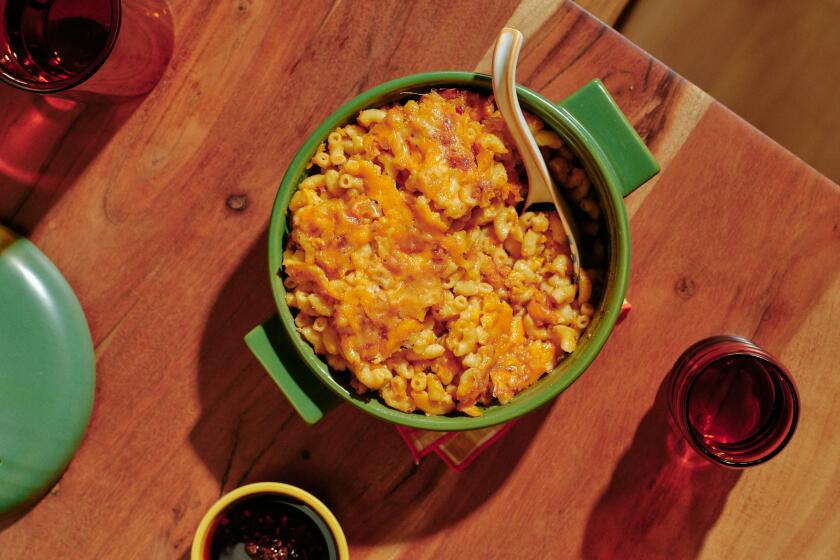Leek Compote With Sweet Corn

On Rosh Hashana, the time-honored greeting, “Have a happy and sweet new year,” is also the message of the menu. In selecting dishes, people are guided not by a prescribed practice but by a popular concept: Eat sweet foods and your year will be sweet.
A favorite way to express the unique tone of the Jewish holiday, which begins Friday at sundown, is to surround the main course (often roast chicken or brisket) with sweet partners.
The side dishes designed for Rosh Hashana are based on vegetables that are naturally sweet. Time-honored choices of Ashkenazi (Eastern and Central European) Jews are carrots and beets. Sephardic (Mediterranean and Middle Eastern) Jews often opt for leeks, which become sweet from slow cooking. Sweet potatoes and pumpkin have become part of the repertoire, and to my own table I like to add red peppers, corn and jicama.
Certain vegetables, whether sweet or not, have additional symbolism. Carrot rounds resemble coins and exemplify the wish for prosperity. The Hebrew word for beets sounds like the verb for getting rid of, and eating them metaphorically encourages heavenly help in chasing out evildoers. Leeks stand for divine protection in a similar way. To express hope for abundance, Sephardic Jews eat black-eyed peas, as American Southerners do at New Year’s, or rice, as Persians do at their new year.
When preparing the holiday vegetables, certain cooks use sugar, prunes and raisins with a liberal hand. I prefer to subtly sweeten my vegetables with a drizzle of honey or a sprinkling of dried fruit.
Sweet spices such as cinnamon, ginger, nutmeg and cloves are a popular foil for the sugar. They beautifully enhance glazed carrots, which I used to make the French way with butter and sugar only, but now accent with cinnamon, honey and dried cranberries.
Following a tip from a Moroccan friend, I use these gentle spices with my butternut squash too. She simmers her squash in meat soup, then presents it and the other soup vegetables around a mound of couscous and powders them abundantly with sugar and cinnamon. I braise my squash instead with a pinch of sugar and spice in a sauce of ripe tomatoes.
Some people avoid lemon juice and vinegar to forestall a bitter year and therefore don’t prepare sweet-and-sour dishes. I find that tomatoes, which are at their seasonal peak around the Jewish New Year, brighten the taste of sweet dishes, contributing a touch of tartness without aggressive acidity.
I often set out a platter of rice pilaf with raisins and nuts, another highlight of the Sephardic holiday kitchen, as an accompaniment for any meat or poultry entree or as a stuffing for peppers or zucchini.
Growing up in an Ashkenazi home, my brother and I never encountered pilaf, but marriage into Middle Eastern Jewish families introduced us to this specialty. Our spouses learned to accept one of our own new year standards--sweet gefilte fish. I’ll let you decide who got the better bargain.
Faye Levy is the author of “1,000 Jewish Recipes” (Wiley, 2000).
Use the white, light and medium green parts of the leeks. Cut off the dark green tops (you can keep them in the refrigerator or freezer for flavoring soups and stocks).
Rinse the leeks briefly to remove surface dirt. Halve them lengthwise and rinse under cold water to remove any sand. Cut the leeks in thin slices. Put in a bowl of cold water and separate the pieces. Let them stand about 5 minutes, then lift them out of the water and drain in a colander. If the water is sandy, soak and drain them again.
Heat the oil in a heavy stew pan or deep saucepan. Add the leeks and salt and pepper to taste. Cover and cook over low heat, stirring occasionally, 5 minutes. Add the corn, thyme and 1/3 cup broth and bring to a simmer. Cover and cook, stirring from time to time, until the vegetables are tender, 15 minutes, adding more broth if the mixture becomes dry. If the leeks are soupy, uncover and cook, stirring often, to evaporate the excess liquid. Taste and adjust seasoning. Serve hot.
Get our Cooking newsletter.
Your roundup of inspiring recipes and kitchen tricks.
You may occasionally receive promotional content from the Los Angeles Times.















